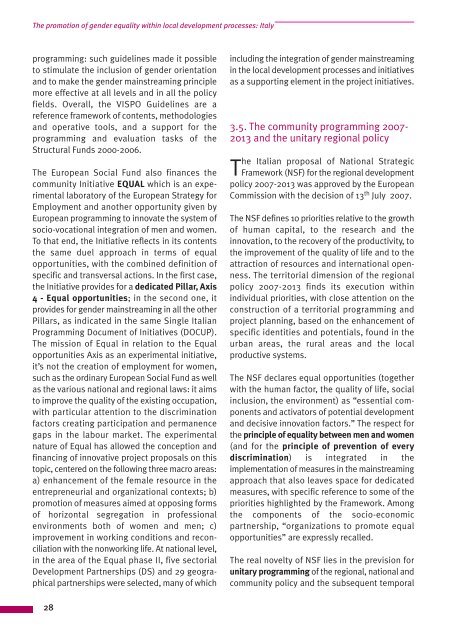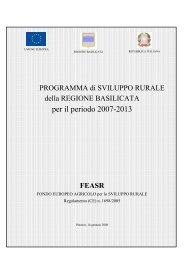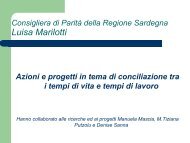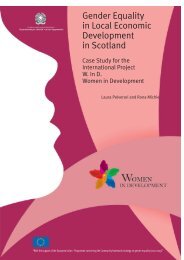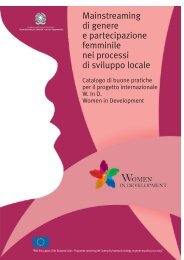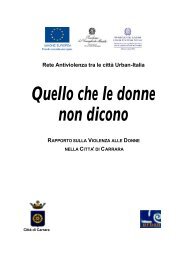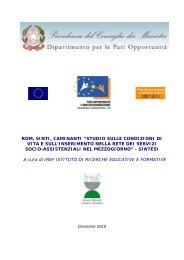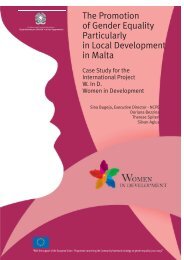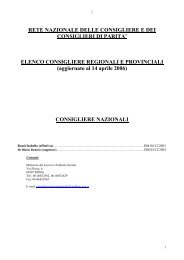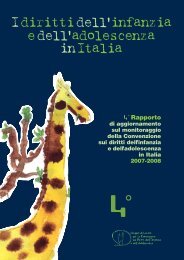The Promotion of Gender Equality within Local Development ...
The Promotion of Gender Equality within Local Development ...
The Promotion of Gender Equality within Local Development ...
You also want an ePaper? Increase the reach of your titles
YUMPU automatically turns print PDFs into web optimized ePapers that Google loves.
<strong>The</strong> promotion <strong>of</strong> gender equality <strong>within</strong> local development processes: Italyprogramming: such guidelines made it possibleto stimulate the inclusion <strong>of</strong> gender orientationand to make the gender mainstreaming principlemore effective at all levels and in all the policyfields. Overall, the VISPO Guidelines are areference framework <strong>of</strong> contents, methodologiesand operative tools, and a support for theprogramming and evaluation tasks <strong>of</strong> theStructural Funds 2000-2006.<strong>The</strong> European Social Fund also finances thecommunity Initiative EQUAL which is an experimentallaboratory <strong>of</strong> the European Strategy forEmployment and another opportunity given byEuropean programming to innovate the system <strong>of</strong>socio-vocational integration <strong>of</strong> men and women.To that end, the Initiative reflects in its contentsthe same duel approach in terms <strong>of</strong> equalopportunities, with the combined definition <strong>of</strong>specific and transversal actions. In the first case,the Initiative provides for a dedicated Pillar, Axis4 - Equal opportunities; in the second one, itprovides for gender mainstreaming in all the otherPillars, as indicated in the same Single ItalianProgramming Document <strong>of</strong> Initiatives (DOCUP).<strong>The</strong> mission <strong>of</strong> Equal in relation to the Equalopportunities Axis as an experimental initiative,it’s not the creation <strong>of</strong> employment for women,such as the ordinary European Social Fund as wellas the various national and regional laws: it aimsto improve the quality <strong>of</strong> the existing occupation,with particular attention to the discriminationfactors creating participation and permanencegaps in the labour market. <strong>The</strong> experimentalnature <strong>of</strong> Equal has allowed the conception andfinancing <strong>of</strong> innovative project proposals on thistopic, centered on the following three macro areas:a) enhancement <strong>of</strong> the female resource in theentrepreneurial and organizational contexts; b)promotion <strong>of</strong> measures aimed at opposing forms<strong>of</strong> horizontal segregation in pr<strong>of</strong>essionalenvironments both <strong>of</strong> women and men; c)improvement in working conditions and reconciliationwith the nonworking life. At national level,in the area <strong>of</strong> the Equal phase II, five sectorial<strong>Development</strong> Partnerships (DS) and 29 geographicalpartnerships were selected, many <strong>of</strong> whichincluding the integration <strong>of</strong> gender mainstreamingin the local development processes and initiativesas a supporting element in the project initiatives.3.5. <strong>The</strong> community programming 2007-2013 and the unitary regional policy<strong>The</strong> Italian proposal <strong>of</strong> National StrategicFramework (NSF) for the regional developmentpolicy 2007-2013 was approved by the EuropeanCommission with the decision <strong>of</strong> 13 th July 2007.<strong>The</strong>NSFdefines10prioritiesrelativetothegrowth<strong>of</strong> human capital, to the research and theinnovation, to the recovery <strong>of</strong> the productivity, tothe improvement <strong>of</strong> the quality <strong>of</strong> life and to theattraction <strong>of</strong> resources and international openness.<strong>The</strong> territorial dimension <strong>of</strong> the regionalpolicy 2007-2013 finds its execution <strong>within</strong>individual priorities, with close attention on theconstruction <strong>of</strong> a territorial programming andproject planning, based on the enhancement <strong>of</strong>specific identities and potentials, found in theurban areas, the rural areas and the localproductive systems.<strong>The</strong> NSF declares equal opportunities (togetherwith the human factor, the quality <strong>of</strong> life, socialinclusion, the environment) as “essential componentsand activators <strong>of</strong> potential developmentand decisive innovation factors.” <strong>The</strong> respect forthe principle <strong>of</strong> equality between men and women(and for the principle<strong>of</strong>prevention<strong>of</strong>everydiscrimination) is integrated in theimplementation <strong>of</strong> measures in the mainstreamingapproach that also leaves space for dedicatedmeasures, with specific reference to some <strong>of</strong> thepriorities highlighted by the Framework. Amongthe components <strong>of</strong> the socio-economicpartnership, “organizations to promote equalopportunities” are expressly recalled.<strong>The</strong> real novelty <strong>of</strong> NSF lies in the prevision forunitary programming <strong>of</strong> the regional, national andcommunity policy and the subsequent temporal28


